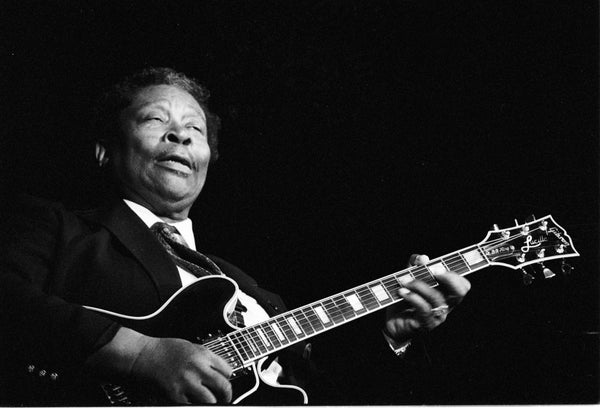This month we bring you a show recorded by BB King for the legendary San Francisco radio station, KSAN at The Showcase Lounge, Oakland, California in February 1971 where the enthusiastic crowd were treated to a swinging performance from King and his road-hardened band. This made-for-radio recording captures King in his early seventies pomp, a reminder of his guitar skills and his eminence as a band leader and entertainer.
King was inducted into the Rock and Roll Hall of Fame in 1987, and is one of the most influential blues musicians of all time, earning the nickname "The King of the Blues". He is considered to be one of the "Three Kings” of the Blues (along with Albert King and Freddie King, none of whom are blood related). But wind back in time a little to ask yourself what he was doing playing to a mainly white audience at The Showcase which was one of the Bay Area’s better known nightclubs for black acts in the sixties and seventies, including Ike & Tina Turner, The Temptations and Jackie Wilson.
The story has been told that, in the wake of The Beatles led ‘British Invasion’ of the mid-sixties, the likes of The Rolling Stones, The Yardbirds, Them (featuring a young Van Morrison, of course), The Animals and The Kinks, to name but a few – whose live sets largely consisted of rave-up covers of old rhythm and blues songs from the repertoire of the likes of Chuck Berry, Bo Diddley, Muddy Waters, John Lee Hooker, Howlin’ Wolf, Willie Dixon, and many others – effectively took musical ‘coals to Newcastle’ by performing material to largely young, white US audiences who would not be familiar with it, owing to the heavily racially segregated mainstream entertainment world of North America at the time. And by the time we get to the latter end of the decade, the likes of Cream had became one of the biggest bands in the world, largely down to their trailblazing touring of the USA playing heavy rock improvisations on Blues-based musical themes. At the same time, there were a lot of young American musicians who were finding their way to the roots of contemporary rock and roll - The Paul Butterfield Blues Band, Canned Heat, Big Brother & The Holding Company, The J Geils Band, Johnny Winter, and many others.
In terms of how the black audiences of the US at the time regarded The Blues, it was arguably viewed as something of an anachronism; contemporary Black music of the late sixties was more focused on the Southern Soul of the Atlantic Records / Stax – Volt stable of acts, with occasional crossing over of rhythm and blues chart hits from other locales making it into the pop chart mainstream. Of course, Tamla Motown had successfully parlayed black pop to an international audience for many years. By the late sixties, the likes of the multi-racial Sly & The Family Stone had injected funk into the pop charts. Artists such as Curtis Mayfield were articulating the Social and Societal concerns of the time. But The Blues? Well, to some, it was the sound of the cotton sack and share-cropping, of the past. It wasn’t the sound of the aspirational young Black audiences of the era, or of the militant black consciousness of the time.
Back in the fifties, black musicians had moved from the South to the big conurbations of the Mid West in search of work in cities such as Chicago and Detroit. Chicago’s South Side was the home to many black workers, and naturally, Clubs opened up to cater for the diaspora’s down time, and rhythm and blues was the soundtrack to the nights spent in them. Many young white musicians (including Paul Butterfield, Barry Goldberg, Steve Miller, Michael Bloomfield, Charlie Musselwhite and Harvey Mandel), bitten by the Blues bug, actually went to those clubs to catch the performers; some even sat in with them, paying homage at the feet of their inspirers. Outside of this, The Blues was to be found in venues on the segregated ‘Chitlin Circuit’ of the Southern States of the US.
By the late sixties, the emergence of an American counter culture was to unexpectedly prove fruitful for the Old School Blues acts. On Sunday, February 26th, 1967, BB King performed at the Fillmore West venue in San Francisco. He played there many times before, to a predominantly black crowd; there was something different about it this time. The kids hanging out at the place when they arrived were white and had long hair. King thought there had been a mistake but after being reassured by the promoter, Bill Graham, King and his band went on as headliners with support from psychedelic group Moby Grape and The Steve Miller Blues Band. Nervous to the point of near collapse, King was hit by the size of the audience. At this point in his career he is mainly playing small club dates, with around 200 to 250 people in attendance. The Fillmore Auditorium holds more than a 1,000 souls.
King’s stock with the burgeoning counter-cultural audience was cemented with that show, and he would go on to perform for Bill Graham numerous times. He would open for The Rolling Stones on their 1969 US comeback tour. However, he was also seasoned enough to know that his loyal, hard core black audience were still out there, too, and that there was no way in which he would abandon them now that the hippie crowd had turned on to him. If James Brown was the self-styled “Hardest working man in show business”, then BB King wasn’t far behind. Although King had a notional residence in Las Vegas, he once said that home was “anyplace I stay three days”.
BB King went on to enjoy a long, long career since the recording of this set. His tenure with the MCA Records label in the seventies would yield some notably big-selling album projects. He had played the Glastonbury Festival in 2011, and the same year had played a sell-out show at London’s Albert Hall. He was still working live and recording up to his death, aged 89, on 14th May 2015.
With thanks to Alan Robinson

